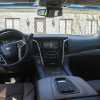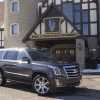If you have ever looked at the sales charts for Cadillac, you begin to notice a trend. While most of their models are seemingly downward or climbing back up slowly, only two models have been somewhat constant; the SRX and the Escalade. We have taken a look at the SRX and have delved into why it's a big seller. Now it's time to take a look at the Escalade and ask why does it do so well?
After the first-generation Escalade, Cadillac has been working on separating the it from the Chevrolet Tahoe/GMC Yukon in terms of design. The second-generation saw an angled front end, distinctive side molding, and a new rear tailgate. The third-generation went a step further with a new grille design, bigger wheels, and other design touches. For this generation, Cadillac decided to sharpen the lines of Escalade to give it a more striking look. Pair this with the large, five-bar grille and vertical LED headlights up front, and the thin LED taillights in the back and the Escalade may have to be one of the best looking full-size SUVs. My only complaint on the Escalade is the new emblem as it looks a bit out of place.
The separation continues inside as the Escalade features the same dashboard as seen on Cadillac’s passenger car lineup. The driver faces a screen which provides the instrument cluster. Cadillac’s implementation of this is one of the best as the screen is clear and vibrant. Also the choice of four different layouts and being able to customize what information is displayed adds a nice touch. That also means Cadillac’s CUE system is present in the center stack. Like other Cadillac models I have driven, the CUE system had its share of slow response time and not recognizing inputs. I’m wondering what Cadillac has in store for the next-generation of CUE and if it can improve its share of problems.
Luxuries are top notch with the Escalade featuring quite the assortment of leather, wood, and piano black trim throughout the interior. Leather wrapped seats provide excellent support for long drives. Front seat passengers get 12-way power adjustments to find that perfect position, while ventilated seats provide an added level of comfort dependent on the season. Second row passengers are treated to captain chairs with heat. Headroom I found to be excellent, while legroom is a little bit tight. Like the Tahoe I drove last year, the Escalade’s third row is best reserved for small kids or to be folded into the floor.For powertrain and ride impressions, see page 2
You only have one choice of engine for the Escalade: A 6.2L V8 with 420 horsepower and 460 pound-feet of torque. The engine makes quite the statement of its intention when you first start it up; sounding more like a Corvette than a truck engine. Despite the Escalade’s curb weight of 5,840 pounds, the 6.2L shrugs it off like nothing. Power is seemingly available through the rev range. Helping matters is a new eight-speed automatic which provides buttery smooth shifts and is barely noticeable. As for fuel economy, the EPA rates the Escalade 4WD at 15 City/21 Highway/17 Combined. My average for the week landed around 13.2 MPG, mostly due to below zero weather and driving in stop and go traffic.
The Escalade’s underpinnings are very much an old-school truck with a live rear axle and body-on-frame construction. But you wouldn’t know that if you took it out onto the road. The ride is very smooth, and no road imperfections make their way in. This is partly due to the Magnetic Ride Control system which quickly adjusts to provide the best ride quality as possible. Also helping is an independent front and five-link rear suspension setup. Steering has excellent weight and feel which makes you feel a little bit more in control with the Escalade. Also Cadillac should be given props for providing a very quiet interior that could rival a library. A noise cancellation system and loads of sound deadening make the Escalade a perfect long distance partner.
My only concern with the Escalade’s driving are the brakes. They don’t inspire much confidence. With a mushy pedal feel and having to push farther on the pedal than should be expected, I felt at times that I wasn’t going to be able to stop it in time. This is something I hope GM addresses in the near future.Why is the Escalade one of Cadillac’s top sellers? I think it comes down to a few reasons. One is that the Escalade is one of the elder statesmen of the class, alongside the likes of the Lincoln Navigator and Range Rover. It also helps that the Escalade is part of the pop culture lexicon. Consider how many pictures or movies/TV shows have stars and music artists driving/riding in an Escalade. That does a lot for a vehicle’s rep.
Final reason? The Cadillac Escalade is just a dang good SUV. The fourth-generation model shows how much work Cadillac put into this. But it should be noted that all of this work and refinement does come at a cost. A 2015 Escalade starts at $72,970, while my Premium 4WD tester rings in at $89,360. That may put some people off, but I feel Cadillac can very much justify it.
In this class, it's about the style, the image, and the luxuries. The Escalade delivers on all three.
Disclaimer: Cadillac Provided the Escalade Premium, Insurance, and One Tank of Gas
Year: 2015
Make: Cadillac
Model: Escalade 4WD
Trim: Premium
Engine: 6.2L EcoTec3 V8
Driveline: Eight-Speed Automatic, Four-Wheel Drive
Horsepower @ RPM: 420 @ 5600
Torque @ RPM: 460 @ 4100
Fuel Economy: City/Highway/Combined - 15/21/17
Curb Weight: 5,840 lbs*
Location of Manufacture: Arlington, Texas
Base Price: $84,070
As Tested Price: $89,360 (Includes $995.00 Destination Charge)
*Note: Weight is for Escalade 4WD equipped with 20-inch wheels
Options:
Kona Brown with Jet Black accents - $2,000
Power Retractable Assist Steps - $1,695
22-inch Dual 7-Spoke Aluminum Wheels - $600.00







-3707742431.jpg.06edf8e14f4ccf35c60d4774a543cc11.jpg)



Recommended Comments
Join the conversation
You can post now and register later. If you have an account, sign in now to post with your account.
Note: Your post will require moderator approval before it will be visible.